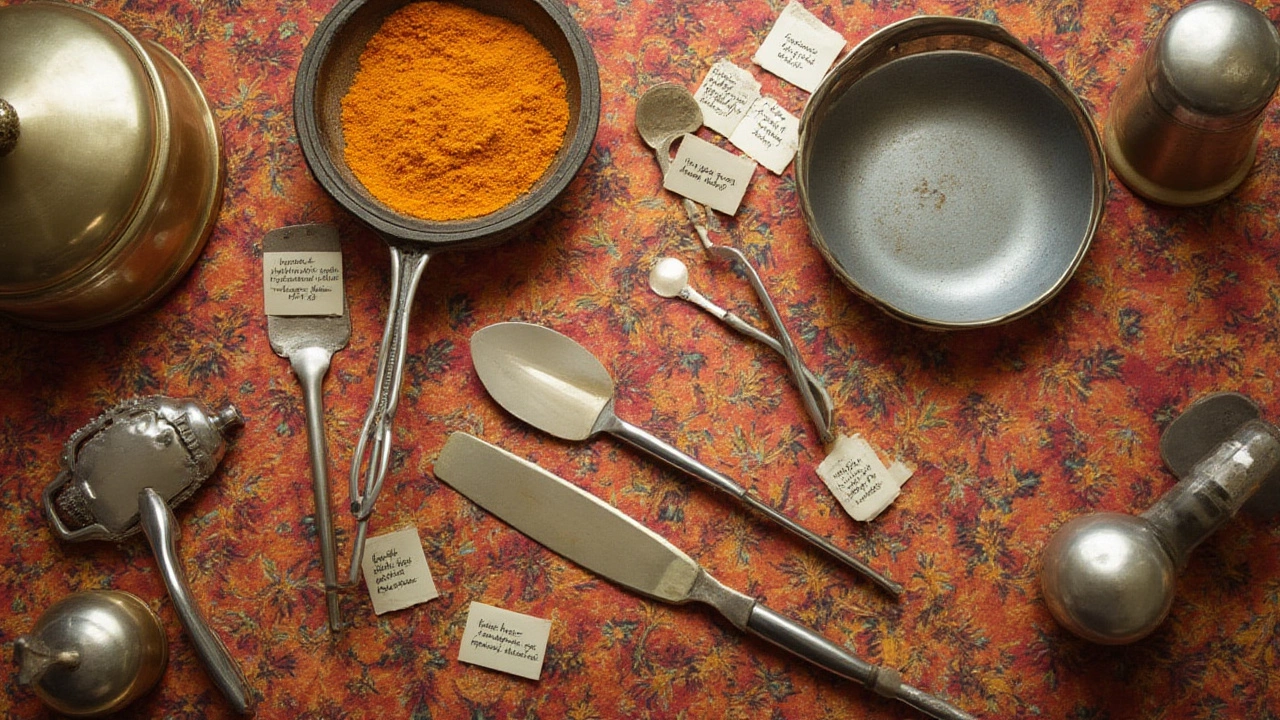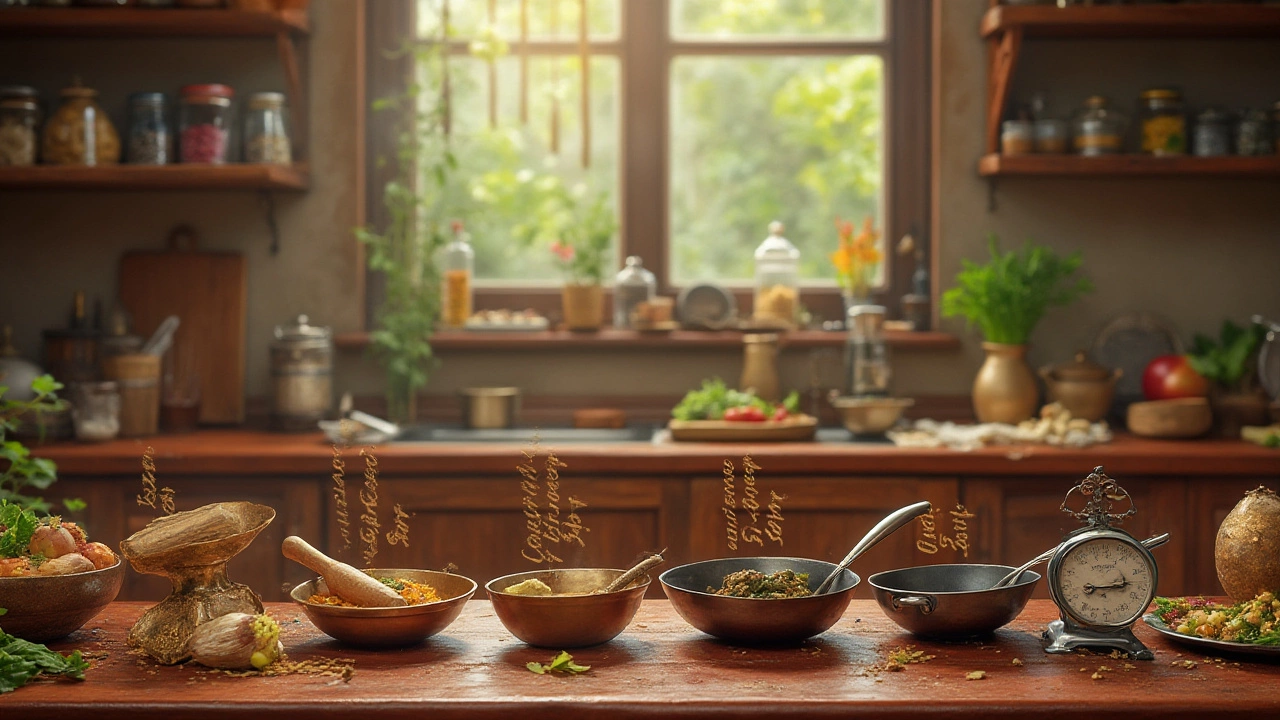You ever notice that we talk a lot about what we cook, but hardly ever about what we actually cook with? Walk into any kitchen—from your grandma’s cluttered drawers to the shiny setups on YouTube—and there’s a wild variety of things with handles, blades, scoops, and edges. You might see a chef swirl a copper ladle in slow motion or a friend clank their fork against a “spatula” that looks absolutely nothing like yours. It’s enough to make you question whether you’ve been calling things the right names all along. And here’s the fun part: almost every kitchen utensil actually has a name, sometimes a story, and often a specific job (even if you’ve been using it to open stubborn jars your whole life). Time to solve the mystery once and for all and truly get to know these handy little tools that keep food moving from the stove to your stomach.
Common Kitchen Utensils and What They're Really Called
It’s honestly a little wild how many times people reach for a “spoon” when they really want a ladle, or grab a “spatula” and end up with a turner. Let’s set the record straight. In everyday kitchens, utensils can be split into categories based on what they actually do: mixing and stirring, serving and portioning, cutting and prepping, and cooking or baking. Some names are plain as day—like a potato peeler or kitchen scissors—but others might surprise you.
First up, those essential basic utensils: the things you always seem to need at the exact wrong moment. The standard kitchen utensils lineup includes:
- Spoons: Different from each other—a slotted spoon (lets liquid drain out), a serving spoon (wide, usually with a deep bowl), and a soup spoon (larger and rounder than a teaspoon).
- Forks: Not just your eating fork. There’s a carving fork (with two big prongs for holding meat steady), and a pasta fork (with teeth to grip slippery noodles).
- Knives: Dozens of types: chef’s knife, paring knife, bread knife, boning knife, steak knife—each designed for a task, not just for hacking away.
- Spatulas: Here’s the drama: what Americans call a spatula is what Brits call a fish slice or a turner. A rubber spatula is for scraping bowls; a metal one slides under pancakes.
- Ladles: Used for serving soup and stew, and yeah, they have their own measurement sizes (like 4oz, 6oz, etc.).
- Whisks: Don’t confuse with a fork—these come in balloon, French, flat, or mini types, each meant for a different whisking mission.
- Tongs: Modern tongs can flip, turn, and serve, sometimes even with silicone tips for nonstick pans.
- Peelers: There are straight peelers (classic potato peeler), Y-peelers, and julienne peelers for matchstick veggies.
- Graters and zesters: A box grater can shred cheese, slice cucumber, or zest lemon—a microplane grater handles finer edges.
- Mashers: Not just potatoes—think guacamole or cooked apples, and some versions even fold for drawer storage.
Ever wonder who decides these names? The answer is, it really depends who you ask. Professional kitchens get picky, but in real life, “thingy” or “doohickey” has carried the day more than once. But here’s a tip: knowing the right names actually helps when you’re looking up recipes or shopping for replacements. “Rubber spatula” versus “offset spatula” will make a difference if you bake.
Getting utensils right can even keep you safer. Accident rates with kitchen knives remain high—especially when people use the wrong type for the job. It turns out, chef’s knives (with their curved blades) help you chop faster and more safely than trying to break down a whole chicken with a paring knife, which can slip and cut you. And if you’ve ever tried to flip pancakes with a flimsy plastic spatula, you know why “fish spatulas” (super thin, flexible, usually with slots) exist. Restaurant cooks swear by them—and you don’t have to cook fish to use them.
Here’s something cool: a survey in early 2025 found more than 60% of home cooks couldn’t identify a balloon whisk, and a surprising number called their flat turner a “spatula,” even when it had slots. As it turns out, regional language plays a big part. In some southern states, “flipper” is the top choice, but on the coasts, “turner” has taken over.
Don’t forget about specialty utensils, either. Ever heard of a spurtle? It’s a Scottish stirring rod, perfect for porridge (and now, TikTok oatmeal trends). Or a mezzaluna? That’s a nifty rocking blade for chopping herbs. Ramekins often sneak onto kitchenware lists—they’re tiny baking dishes, not utensils, but you’ll find people using the name for mini prep cups. Yup, names are a fun, messy business when it comes to the kitchen.
And if you think modern utensils are all stainless steel and silicone, check your local thrift store or a friend’s grandma’s kitchen. There’s still a lot of wood, ceramic, and even horn or bamboo out there—each with their own quirks. Some professional kitchens report wooden spoons are less likely to transfer heat, which means fewer burned hands when stirring sauces that bubble and spit.
| Utensil | Primary Use |
|---|---|
| Slotted Spoon | Strains liquid from solid food |
| Ladle | Serves soups and stews |
| Chef’s Knife | Chopping and slicing vegetables & meat |
| Paring Knife | Peeling and detailed cutting |
| Tongs | Grabbing, flipping, and serving hot food |
| Whisk | Mixing and aerating ingredients |
| Rubber Spatula | Scraping bowls and folding mixtures |
| Turner | Flipping food in pans |
| Grater | Shredding cheese, vegetables, zest |
| Potato Masher | Mashing soft food |
If you’re building your first kitchen, start with these basics. You’ll save yourself the headache of trying to whisk eggs with a dinner fork or burning your hands fishing out toast with a butter knife.

Oddballs and Unsung Heroes: Unusual Utensils Worth Discovering
The real fun in kitchen utensils starts when you look beyond the basics and run into weird-looking gadgets hiding in a drawer. You might spot something that looks like a spiderweb on a stick—that’s a skimmer or spider, perfect for fishing out dumplings or fried food from hot oil. Or see a sturdy, flat disk with holes and a handle? Potato ricer, dear reader. Works magic on making gnocchi and the creamiest mashed potatoes you’ll ever taste.
Ever owned a garlic press? Some people swear it’s a waste, others won’t chop a clove without it. Then there’s the zester—sometimes mistaken for a grater but designed to shave only the fragrant outer peel off citrus fruit, not the bitter white part underneath. For salad fans, salad tongs aren't just decorative: they're shaped for tossing greens without bruising them, according to a well-known chef from a Chicago plant-based restaurant. And salad spinners? Technically not a utensil, but their plastic baskets have saved many a home chef from soggy salad syndrome.
Some utensils look so niche that they feel almost unnecessary until you actually use them. An avocado slicer is one of those—safer and cleaner than juggling a knife around slippery fruit. Apple corers, melon ballers, cherry pitters: if you cook a lot of fresh produce, these will save you time and probably a few bandaged fingers. And don’t knock the pastry brush—it's not just for desserts but perfect for coating roasting meats or veggies in oil and marinade.
Take the case of the dough scraper—basically a flat piece of plastic or steel with a handle. It sounds boring, but it’s actually genius for scooping, scraping, and slicing through sticky bread dough with zero fuss. Then there’s the microplane grater, originally designed for woodworking, now a superstar for zesting citrus or grating hard cheese. Strange origin story? Yes. Ridiculously useful in the kitchen? Absolutely.
Another interesting tool is the egg separator. Sure, you can use the eggshell, but with a purpose-built separator, you avoid broken yolks and your hands stay clean. If you bake (even infrequently), this thing is a tiny time-saver you never realize you want until it’s 11 pm and you’re cracking eggs for brownies.
Then, we hit measuring cups and spoons. Everyone’s seen them, but getting a good set with clear markings (and metric plus US cups) is key to baking success. Precision matters—a Stanford home baking study from spring 2025 found that people who measured flour by volume instead of weight ended up with wildly different results. And while we're here, a kitchen scale is arguably the single best investment if you want consistently good bread, cookies, or pizza dough.
What about those odd tools you see once and never again? Fish bone tweezers pop up in seafood kitchens, dedicated pizza cutters zip across pies in one go, and spiralizers make veggies into Instagrammable noodles. If you get obsessed with making something—sushi, dumplings, ice cream—you’ll find specialized utensils waiting for you, like rice paddles, bamboo rollers, or scoops shaped just for the job.
Some people collect utensils the way others collect comic books. If that sounds like you, consider glass or ceramic utensils (like butter bells for spreading soft butter or tiny salt cellars)—they look pretty and work just as well as metal or silicone, with a little more personality. Even a mortar and pestle (used for centuries) still beats a food processor for bashing up herbs the old-school way.
| Utensil | Surprising Use |
|---|---|
| Spider Skimmer | Removes pasta or fried food from boiling water/oil |
| Pastry Brush | Applies marinades and egg wash |
| Egg Separator | Quickly separates egg white from yolk |
| Microplane Grater | Zests citrus and grates cheese |
| Avocado Slicer | Safely opens, pits, and slices avocados |
| Potato Ricer | Makes fluffy mashed potatoes and gnocchi dough |
| Salad Spinner | Dries salads fast, avoids soggy greens |
| Dough Scraper | Cuts and lifts sticky dough from counters |
It’s easy to brush off these oddballs as unnecessary clutter—until you see how they solve a tiny, irritating problem, almost instantly. You don’t need every tool ever invented, but embracing a couple of these unsung heroes can actually make cooking easier, faster, and a bit more fun.

Choosing and Caring for Your Utensils: Tips for a Smarter Kitchen
If you open your drawers and wonder why you have three broken spatulas, or why half your spoons are warped and impossible to use, trust me—you’re not alone. The secret to happy cooking isn’t owning every fancy tool. It’s picking the right ones and keeping them in shape.
Start by thinking about what you actually do in your kitchen. Love baking? Invest in a good balloon whisk, a silicone spatula, and solid measuring cups. More of a stir-fry type? Tongs and a wok spatula should be on your must-have list. For soup lovers, a deep ladle and slotted spoons make your life easier. And if you grill, long-handled tongs and basting brushes are essentials. There’s no universal “perfect” lineup—pick utensils that match your actual cooking, not just the looks of them.
When shopping, don’t just focus on shiny packaging or internet ads. Pay way more attention to how each utensil feels in your hand. Lightweight plastic can snap at annoying times; wood or bamboo feels great but needs gentle care (keep them away from the dishwasher, and don’t let them soak forever). Metal is durable, but aluminum can discolor and shouldn’t meet acidic foods. Silicone has become more popular since it handles heat and doesn’t scratch pans—just check it’s FDA-approved for food.
Look for utensils that are easy to clean and don’t have tricky nooks and crannies where food gunk can hide. The best spatulas or whisks come in one or two pieces—not four, because those metal joints will trap bacteria. Pro tip: if you’ve ever had a spoon or peeler that changed color or started to stink, it’s probably not dishwasher safe. Always check the label.
A lot of times, “multi-use” beats “single-use.” A chef’s knife can chop veggies, slice fruit, and smash garlic. A rubber spatula scrapes batter from bowls, folds egg whites, and spreads icing. If drawer space is tight, choose versatile pieces over one-trick gadgets, unless you’re really into niche recipes.
Take care of your favorites and they’ll last for years. Hand wash wooden utensils, dry them quickly, and rub in a little mineral oil every so often to prevent cracking. Store knives in a block, a sheath, or on a magnetic strip to keep them sharp and safe (sheaths are especially good if you’re short on counter space). Never dump sharp knives into a drawer; it’s basically begging for nicks and cut fingers. For peelers and graters, check blades occasionally—dull ones are actually more dangerous, since you’ll push harder and slip.
If you inherit vintage utensils—hand-me-downs, flea market scores, or grandma’s favorite potato masher—enjoy them! Sometimes older pieces are better made than store-bought modern ones. Just clean up any rust spots with a paste of baking soda and water, and always dry completely.
Kitchen hygiene doesn’t get talked about enough. Change dish sponges and scrub brush heads frequently (at least once a month). Utensils that touch raw meat like tongs, knives, or cutting boards? Wash them in hot, soapy water pronto to avoid spreading bacteria. Pro chefs say the easiest way to make your kitchen safer is matching your tools to the job—and cleaning as you go. There’s no shortcut around it.
Storing utensils can be a thing of beauty, too. Mason jars keep whisks and spatulas standing tall. Drawer dividers mean you can actually find your potato peeler when you need it. If your kitchen’s tight on space, consider magnetic racks for metal utensils or wall hooks—just don’t hang wooden ones near a stove or sink, since steam can warp them.
If you’re building a registry or wish list, go for quality over quantity. Even studies in 2024 kitchen consumer surveys showed that people with fewer but higher-quality utensils cooked at home more often and wasted less food (fewer failed kitchen experiments mean fewer takeout nights). Trying new recipes is more fun when you have the right gear, not a cluttered drawer full of broken plastic forks.
| Tip | Why It Matters |
|---|---|
| Choose by use, not by trend | What works for you is better than what’s "in" |
| Check for food safety labels | Healthier cooking, especially with silicone |
| Prioritize one-piece designs | Less risk of broken handles, easier cleaning |
| Keep wood dry and oiled | Prevents cracking and mold |
| Use drawer dividers or jars | Makes utensils easy to grab, not dig for |
| Store sharp tools safely | Prevents accidents and keeps blades sharper |
At the end of the day, kitchen utensils are whatever you reach for, time and time again. The real magic happens when you know their names, respect their quirks, and pick the right one for what’s on your plate tonight. Maybe now that lonely tool in your drawer has a name—and a new purpose. Happy cooking!
